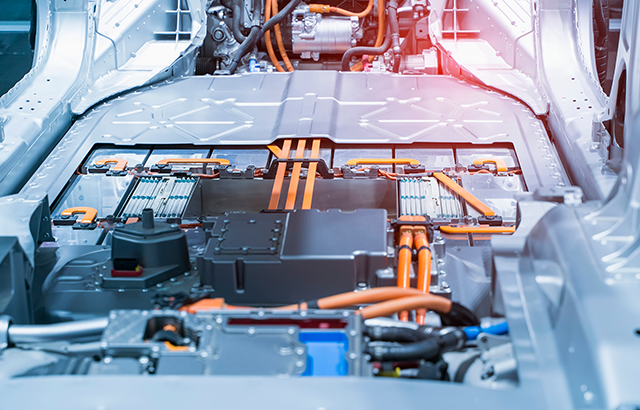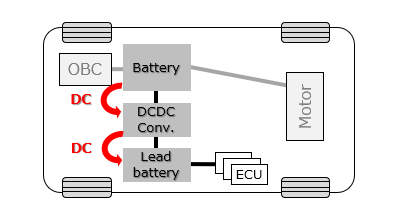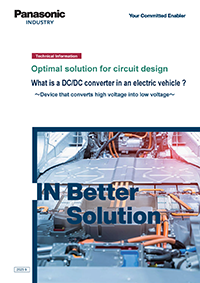What Is a DC/DC converter in an Electric Vehicle (EV)?
- Device that converts high voltage into low voltage -
2023-09-22

An electric vehicle (car) is equipped with a large, high-voltage lithium ion battery and with a low-voltage lead battery used in engine vehicles as well. Both batteries need to be charged. The lithium ion battery is charged at a charging station, and the lead battery is charged with power from the lithium ion battery. When the battery is charged, a DC/DC converter converts high-voltage DC power into low-voltage DC power. This article will discuss the functions and system configuration of the DC/DC converter, and will introduce electronic components making up the converter as well.
1. What is a DC/DC converter?
1-1. Brief description of the DC/DC converter
Every component constituting an EV operates on electricity. The motor that causes the vehicle to travel (travel motor) operates on power from the large, high-voltage lithium ion battery, while numerous other components (the ECU, cameras, lights, etc.) operate on power from the low-voltage lead battery. The lead battery becomes low on power to feed when left uncharged. It needs to be charged with power from the lithium ion battery. Now, high-voltage DC power from the lithium ion battery needs to be converted into low-voltage DC power with which the lead battery is charged, and the DC/DC converter makes this conversion. Low-voltage DC power resulting from the conversion allows various components in the EV to operate with proper voltage supplies.

1-2. High-voltage applications and low-voltage applications
- High-voltage applications
The travel motor needs high voltage to operate with. Because the motor has a large power capacity, trying to run the motor with low voltage supply creates a large current flow in the motor, which increases in-circuit loss, thus leading to lower conversion efficiency. Improving the conversion efficiency requires a high voltage supply (400 V or higher) to the motor, which keeps the current flow therein small. - Low-voltage applications
Low voltage is supplied to components not related to the travel motor, such as various pieces of equipment in the vehicle interior and head lights. Even a device that runs on high voltage has an internal control circuit that runs on low voltage. For these reasons, the DC/DC converter that converts high-voltage DC power into low-voltage DC power is essential to the vehicle.
1-3. Why is a 12 V battery used for low-voltage components?
Cars in the early days of the automobile history carried engines that had to be manually started. Thereafter, the starter system was developed. In those days, each car carried a lead battery to kick start the starter. Currently, a passenger car carries a 12 V battery composed of six lead battery cells (each of which generates a voltage of about 2.1 V). However, a truck with a large starter usually carries a 24 V battery (composed of two 12 V batteries).
2. Trends in the market and demand for the converter
As the number of EVs on the market increases, the number of DC/DC converters incorporated in EVs will also increase. Facing an increase in power-operated pieces of equipment, the DC/DC converter has to be ready to deal with high-power applications. In addition, the DC/DC converter itself has to be capable of higher power output while remaining compact in size. To meet these requirements, electronic components making up the DC/DC converter need to have the following important properties: high voltage (high withstand voltage), large current, low loss, high resistance to heat, small size, and high precision.
3. Circuit configuration of the DC/DC converter
3-1. Overall configuration
- Voltage detection circuit (input side):Measures an incoming voltage from the lithium ion battery
- Noise filter (input side):Composed of capacitors and a coil to eliminate noise
- Voltage conversion circuit:Converts voltage through an insulation transformer and FETs that switch on/off
- Noise filter (output side):Composed of capacitors and a coil to eliminate noise
- Voltage detection circuit (output side):Measures an output voltage
- Control circuit:Controls the conversion circuit, etc.
- DC/DC converter:Supplies power to the control circuit
- Communication circuit:Communicates with external equipment

4. Individual circuits and components
4-1. Voltage measuring circuits (input/output)
The circuit measures an input voltage and an output voltage respectively to control the voltage conversion circuit. In general, it measures a voltage across both ends of resistances connected in series.
Voltage measurement: Chip resistor (high-precision chip resistor)
POINT- ❶ The chip resistor with a thin-film structure offers a small resistance tolerance and a low TCR, thus contributing to high-precision control of the output characteristics of the circuit.
4-2. Noise filters (input/output)
Each noise filter suppresses internal noise as well as external noise to prevent malfunctioning of the DC/DC converter. The filter is composed of a large inductor and film capacitors or conductive polymer hybrid aluminum electrolytic capacitors.
Noise elimination: Film Capacitors (Automotive, Industrial and Infrastructure Use)
POINT- ❶ High reliability: The film capacitor offers high resistance to humidity and to thermal impact, and conforms to AEC-Q200.
- ❷ High safety: With its security mechanism (fuse), the film capacitor ensures high safety. (The circuit is put into an opened state in failure mode.)
Noise elimination, smoothing: Conductive polymer hybrid aluminum electrolytic capacitor
POINT- ❶ The capacitor offers high capacitance, low ESR, and high ripple-suppression performance, thus contributing to a reduction in the size of the circuit and an increase in the power capacity (low voltage and large current) of the circuit.
- ❷ Having capacitance characteristics to cut off high-frequency components, the capacitor eliminates high-frequency broadband noises that are generated by the high-frequency switching of the circuit.
4-3. Voltage conversion circuit
The voltage conversion circuit converts voltage through a transformer and switching elements that switch on/off. The switching elements' switching on/off, which makes voltage conversion, creates noise. This noise is suppressed by using resistances as the gate terminals of the elements.
Suppressing gate-driving noise by the switching elements: Chip resistor (small and high-power chip resistor)
POINT- ❶ With its original resistance pattern, electrode structure, etc., the chip resistor is small in size and yet handles high-power operations, thus contributing to a reduction in the size of the circuit.
4-4. DC/DC converter
In the DC/DC converter, generally, a conductive polymer hybrid aluminum electrolytic capacitor is used to eliminate noise on the input end and to smooth voltage output from the output end, and an in-vehicle power inductor is used for voltage conversion.
Noise elimination, switching, and smoothing: Conductive polymer hybrid aluminum electrolytic capacitor
POINT- ❶ The capacitor offers high capacitance, low ESR, and high ripple-suppression performance, thus contributing to a reduction in the size of the circuit and an increase in the power capacity (low voltage and large current) of the circuit.
- ❷ Having capacitance characteristics to cut off high-frequency components, the capacitor eliminates high-frequency broadband noises that are generated by the high-frequency switching of the circuit.
Voltage conversion: Power Inductors for Automotive application
POINT- ❶ The inductor made of a metal magnetic material allows less power loss and carries a large current, thus contributing to a reduction in the size of the circuit and an increase in the power capacity (low voltage and large current) of the circuit.
- ❷ Having loss characteristics in a higher frequency range (low ACR), the inductor contributes to the suppression of power loss caused by high-frequency switching of the circuit.
4-5. Communication I/F
The communication I/F circuit communicates with external equipment (CAN, Ethernet, etc.) through two communication lines. If noise or static electricity enters via these communication lines, it may cause a transceiver IC to fail. To prevent such problems, the transceiver IC is usually provided with chip varistors serving as electrostatic control measures.
ESD noise elimination: Chip varistor
POINT- ❶ With a wide range of capacitance characteristics, the chip varistor suppresses electrostatic discharge (ESD) noise while keeping the communication quality of the circuit intact.
- ❷ With its capacitance ranging from 8 pF to 250 pF, the chip varistor operates effectively at low to high communication speeds.
5. Summary
In an EV, many in-vehicle equipment (except the motor) operates at a voltage far lower than the source voltage of the EV. The DC/DC converter is therefore needed to convert the high-voltage DC power output from the lithium ion battery, into low-voltage DC power. As more and more EVs are produced, more and more DC/DC converters are expected to be incorporated in EVs.
The DC/DC converter with high power output is now in demand as electrical in-vehicle equipment running on high power increases. There will be increasing demand that in-vehicle electronic components have these properties: "high voltage (high withstand voltage),” "large current,” "low loss,” "high resistance to heat,” and "small size.” Panasonic Industry offers a wide variety of products for use in the DC/DC converter (Table 1).
| Component | Feature | High voltage | Large current | Low loss | Miniaturization | High heat resistance | High precision |
|---|---|---|---|---|---|---|---|
Film Capacitors (Automotive, Industrial and Infrastructure Use) |
High reliability | ✔ | ✔ | ||||
Conductive Polymer Hybrid Aluminum Electrolytic Capacitors |
Low ESR High reliability |
✔ | ✔ | ✔ | ✔ | ✔ | |
Power Inductors for Automotive application  |
Large current, low loss High reliability |
✔ | ✔ | ✔ | ✔ | ||
 |
High precision, high resistance to heat | ✔ | ✔ | ✔ | ✔ | ✔ | |
Chip Varistor |
Small and light | ✔ |


